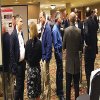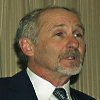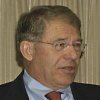Building for better times
14 June 2010Around 125 registrants from seven countries greeted 23 speakers under sodden skies, interspersed with blue patches revealing Seattle’s bayfringed skyscrapers.
The pundits appeared to agree that the worst of the economic conditions had, or soon would, pass.
There is more recognition that the world’s heavy dependence on oil is putting the squeeze on panel producers. It’s the movement towards wood, or ‘biomass’, as an energy generator and consequent rising raw material costs as power competes with panels for a shrinking supply of residuals.
Lynn O Michaelis, president of Strategic Economic Analysis, LLC, Seattle, Washington, keynoted the session with thoughts on the economic situation. He declared: “Every historical relationship doesn’t work this year. Most cycles are caused by tight money. This one was not. Housing activity is still down. It went from 1.7m down to 340,000. Most industries did fairly well, compared with housing. There is a massive OSB over-supply. The North American recovery is based on extreme policy measures and inventory correction.
“Asia is booming, primarily because of China,he explained, while Europe is extremely sluggish – the Greek crisis impacted on the Euro. Latin America, except for Venezuela and Argentina, has benefited. The US dollar is under pressure, but Canada is in pretty good shape, he said.
He believes the worst is over, but it is likely to be a slow recovery. The US financial system is still not completely well. Small banks are hurting. Consumer confidence is extremely low. Furniture is in a 30% decline, but is much better than housing. The US dollar is likely to remain under downward pressure.
Craig Adair of APA-The Engineered Wood Association, Tacoma, Washington, predicted US economic recovery this year. He said the present wood products recession “may have begun in 2004-5 when prices peaked and housing starts began retreating from two million per year.”
He said the housing and economic recessions, as well as environmental concerns, are stimulating innovations in more effi- cient use of wood fibre, energy savings in buildings, and an edge for wood over non-wood products for environmental reasons.
Outlining newer products, he described structural insulated sheathing as one-third the weight of OSB and meeting or exceed- ing structural codes. I-stud walls using miniature I-beams are another, along with glulam utility towers.
Mr Adair said product innovation will continue and that wood will eventually be favoured over non-wood products. There is a slow recovery in housing starts, which will reach underlying demand in 2013.
He said the housing boom and bust has been both good and bad for OSB. “We have seen a big OSB decline; 2009 was dismal for glulam.”
He predicted more laminated strand lumber (LSL). He said straight, tall walls are more easily built with engineered wood.
Paul M Smith, Pennsylvania State University, said China’s forest products output has increased 1000% in the last decade. “They have modern technology in some plants but have thousands and thousands of small, labour-intensive, mills. There are 700 particleboard plants. US is, by far, China’s largest market for forest products.
He reported that 1% of US energy supply comes from woody biomass.
Professor Smith said the global community is engaged in green policy debates that directly impact US forests and forest prod- ucts industries. Some of these well-intentioned ‘green rules’ may result in unintended consequences: “As firms consider the triple bottom line of people, planet, and profit they must balance these with the realities of global competition in a weak business climate,he said.
Michael Wolcott, WSU, said: “The industry is on the precipice of a change into a new, unknown, economic system, but one where carbon plays a much larger role. Society’s mandates for national energy security, decreased carbon emissions and reduced health care costs are beginning to shape our offerings”.
On the life cycle side he emphasised design for end-of-life, better integration into building systems and longer product life.
David Smith, Oregon State University, emphasised that government incentive programmes to encourage renewable fuel use are distorting the value of clean sawmill residuals and diverting them from long-established particleboard and MDF markets to lower-value fuel applications.
Joseph A Kocal, UOP LLC, Illinois, said US government policy is driving substitu- tion of biologically-derived feedstocks for petroleum feedstocks, however the debate over biofuel as a sustainable source of liq- uid transport fuels continues. This debate includes life cycle analyses of biofuel production routes, including low yields of biofuels from crops that would otherwise be used for food production, the poor energy balance for producing some biofuels, and a lack of production/distribution networks.
There are intense efforts to develop technologies to process second-generation feed- stocks such as agricultural residues, forest wastes and hardwood-biobased composites.
Michael Lepech, Stanford University, California, said the forest products industry is being reinvented. It was formerly integrated and holistic to maximise fibre value with operational buffers for stabilised markets.
He said small pieces or processes have large impacts. Life cycle analysis can play a large role in a firm’s activities in marketing, R&D and strategy. Opportunities exist in green products, if approached properly.
J Daniel Dolan, WSU, warned that building and energy codes determine how products will be used in construction and renovation of buildings. How they are written can have a drastic effect on how, or which, individual products are used, affecting the market share of particular products.
He declared, “We have made the recipe for building houses so complicated that it became unworkable. You need to get involved so alternatives are allowed for use of different products”.
Vikram Yadama, WSU, described a lightweight panel developed at the University. It does the same work as an equivalent OSB panel, using half the fibre and resin. With proper engineering, the panel supports typical residential loads. He said it opens the potential for ‘panelised construction’, with bending strength with an 88% advantage over OSB.
Maxim Peretolchin, BASF, Ludwigs-haven, Germany, described his firm’s Kaurit lightweight board, which he said has a high-strength core layer, smooth and dense surface layers and good edge quality. The product consists of wood chips, Kaurit Light polymer, and Kaurit glue binder. The polymer is foamed before being added to the wood chips and then mixed with glue before being deposited onto a band running through a continuous hot press. He said the finished product has 430kg/m3 of wood per compared with 640 kg/m3 in conventional particleboard.
Overall, he said the product has: a 30% weight reduction; wood savings; high internal bonding due to adhesive effect; water repelling effect; and good edge quality.
Mr Peretolchin said it is compatible with existing board production and furniture manufacturing procedures.
Michael Malmberg, Hexion Specialty Chemicals, Montana, said recent changes in CARB (California Air Resources Board) regulations for the wood fibre industry have drastically changed expectations of North American wood panel customers, present- ing challenges to the industry.
Most North American MDF and particleboard producers are currently at CARB Phase I formaldehyde-emitting levels. Amino resin producers have successfully provided CARB Phase I low formaldehyde- emitting resins. He said Hexion has developed technology to aid panel producers in meeting CARB Phase II levels.
He advised that designs must incorporate as high amounts of solids as possible. Lower-emitting resins have a shorter shelf life. The new technology has had successful trials in both MDF and particleboard.
W Ernest Hsu, Consultant, Vancouver, Washington, said: “Every OSB manufacturer wants a competitive advantage – the ability to be consistently more profitable than competitors in the same market. In order to achieve and maintain this advantage, an OSB manufacturer must solve the following challenges: reduced costs, flexible production and diversification”.
He said the presence of fines might be the root cause for many OSB quality problems and that the industry put more effort into increasing fines in the panel than to reducing fines generation during processing. To reduce fines, measures must be taken in log storage, conditioning, debarking and feeding, stranding and screening.
Michael Maes, Titan Wood BV, Arnhem, The Netherlands, described his company’s acetylation process, which transforms free hydroxyl groups in wood (responsible for swelling and shrinking) to acetyl groups. Water absorption is greatly reduced and the wood is no longer digestible. It becomes quite dimensionally stable and durable.
Titan is developing the technology to commercially produce wood based panels based on acetylated wood elements.
Günter Natus, Dieffenbacher, Germany, remarked that biofuel pellet plants and the wood panel industry compete for the same raw material, but pellet producers enjoy subsidies and can pay more for the wood. The pellet industry is growing and the bio-fuel industry will require more biomass.
Mr Natus said engineered wood products do not enjoy the attention of the public. A ‘green’ wood panel is not seen as ecological. He proposed using recycled wood as raw material. The material is available. He said pellet plants can’t use high-ash-content raw material and that particleboard/OSB plants can be retrofitted to produce pellets with limited investment and fast transition, but this works only with perfect logistics.
Mr Natus suggested combining a bio-mass power plant with a board plant, also using wood as raw material for bioethanol and panels.
Spencer Perry, University of Maine, commented that strand orientation and mat density are two of the largest considerations in OSB manufacturing.
His university is developing a computer program to control these variables and allow mills to adjust forming line parameters in the computer and simulate the resultant final product. When the optimum solution is found, the forming line adjustments can be made quickly and accurately to limit downtime, he said.



